Sheep attacks and harassment: research
Findings from survey research on sheep worrying and wildlife attacks on sheep.
4. Prevalence of dog attacks and wildlife attacks
Prevalence of dog attacks
Overall, half (51%) of all sheep farmers in the survey indicated that, at some point, their sheep had been attacked or chased by dogs (Figure 4.1).
Figure 4.1 Whether sheep have ever been attacked or chased by dogs and the last time this happened (% sheep farmers)
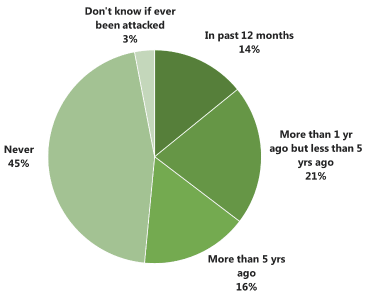
Base: All (n=1931)
Fourteen per cent of sheep farmers reported that their sheep had been attacked or chased by dogs in the previous 12 months.
Factors associated with a greater likelihood of experiencing a dog attack in the previous 12 months were:
Larger flocks (7% of those with fewer than 20 sheep had experienced a dog attack in the previous 12 months, compared with 17% of those with 20-149 sheep, 14% of those with 150-749 sheep and 20% of those with more than 750 sheep)
Sheep on fully open land (with no inbye) or open land with all/some lambing in bye (20% and 18% prevalence respectively compared with 12% where land is fully enclosed)
Having a track or road which is regularly used by dog walkers close to any of the sheep (19% prevalence among those with such a track or road compared with 5% of those without).
Being located in Lothian or East Central Scotland (28% prevalence in each case). There were fewer attacks in North East Scotland (8% prevalence) than elsewhere.[42]
There was no difference in the 12 month prevalence of attacks between those located in accessible rural areas, remote rural areas or very remote rural areas.[43]
Among those reporting any attacks in the past 12 months, 43% had experienced one attack and 57% had experienced more than one (see Figure 4.2 below). The mean number of attacks was 3.5, the median number of attacks was 1.2 and the maximum reported was 250. While this number of attacks was very unusual, and the result of multiple attacks over a sustained period, these situations have a huge impact on the businesses of the individual farmers concerned.
Figure 4.2 Number of separate dog attack incidents in past 12 months among those who had experienced any (% sheep farmers who experienced at least 1 attack in the past twelve months)
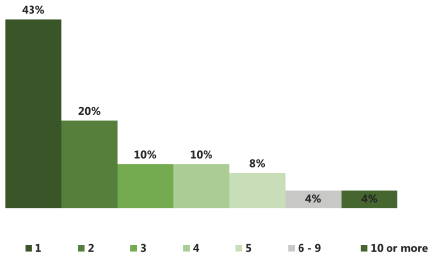
Base: All who had sheep chased or attacked by a dog in the past 12 months (n=293)
There were no significant differences in the types of farmers or farms who had had multiple attacks, compared to those who had had any attacks in the past 12 months.
Estimated total number of dog attacks
It is possible to extrapolate from the figures above to produce an estimate of the total number of incidents of dogs attacking or chasing sheep in Scotland within a 12 month period. While this estimate gives some indication of the potential scale of the problem, it should be treated with considerable caution as it is subject to wide confidence intervals and the limitations of any survey of this nature (e.g. the potential for non-response bias and recall inaccuracies). The estimated total number of incidents of dogs chasing or attacking sheep in Scotland in the period 1 May 2018 to 30 April 2019 is around 7,000, with the true figure likely to be within the range of 4,500 to 10,000.[44]
Prevalence of wildlife attacks
Overall, 64% of all sheep farmers in the survey indicated that, at some point, their sheep had been attacked, chased or preyed on by animals or birds other than dogs (Figure 4.3). They were asked only to include attacks on live sheep, not scavenging of dead sheep.
Figure 4.3 Whether sheep have ever been attacked, chased or preyed on by any other animals or birds other than dogs and the last time this happened (% sheep farmers)
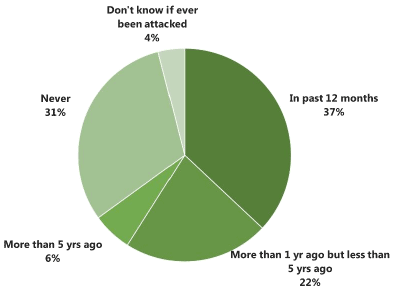
Base: All (n=1931)
Thirty-seven per cent of sheep farmers reported that their sheep had been attacked or chased by wildlife in the previous 12 months.
Factors associated with a greater likelihood of experiencing a wildlife attack in the previous 12 months were:
Larger flocks (10% of those with fewer than 20 sheep had experienced a wildlife attack in the previous 12 months, compared with 46% of those with 20-149 sheep, 26% of those with 150-749 sheep and 70% of those with more than 750 sheep)
Sheep on open land with all/some lambing in bye (51% of those with sheep on this type of land had experienced a wildlife attack in the previous 12 months, compared with 31% of those with sheep on fully open land (with no inbye) and 33% of those where land is fully enclosed)
Being located in East Central Scotland (64% prevalence), Argyll & Bute (57%), Ayrshire (53%) or Dumfries & Galloway (48%). There were fewer attacks in North East Scotland and Eileanan an Iar (26%) than elsewhere.
Being located in a remote rural area (44% prevalence) rather than an accessible rural area (36%) or a very remote rural area (37%).
Among those reporting any attacks in the past 12 months, more than half (54%) had experienced five or more separate incidents (see Figure 4.4 below). The mean number of attacks was 9.4, the median number of attacks was 4.1 and the maximum reported was 400. While this maximum figure is an outlier, and very rare, such extreme cases could have potentially huge impacts on individual businesses.
Figure 4.4 Number of separate wildlife attack incidents in past 12 months among those who had experienced any (% sheep farmers)
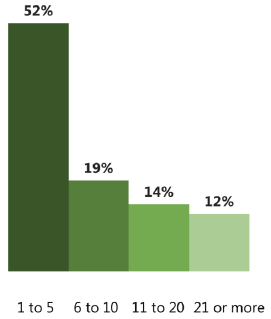
Base: All who had sheep chased or attacked by wildlife in the past 12 months (n=840)
The different species of wildlife involved in these attacks is discussed in Section 5 below.
Estimated total number of wildlife attacks
It is possible to extrapolate from the figures above to produce an estimate of the total number of incidents of wildlife predation on sheep in Scotland over a 12 month period. Again, however, these estimates are subject to wide confidence intervals and the limitations of any survey of this nature (not least because most wildlife incidents are unobserved and farmers are generally only aware of incidents where the aftermath, such as the disappearance of a lamb or an injured sheep, is obvious). They should therefore be treated with extreme caution. Bearing those caveats in mind, but to give some indication of the potential scale of the problem, the estimated total number of incidents of wildlife attacking, chasing or preying on sheep in Scotland in the period 1 May 2018 to 30 April 2019 is around 50,000, with the true figure likely to be in the range of around 45,000 to 55,000.[45]
Views on the severity of the issues
Farmers were asked how much of a problem they thought dog attacks and wildlife attacks were - both for them, personally, and for other farmers in their area (Figure 4.5).
Overall, wildlife attacks were perceived as a bigger problem than dog attacks: 48% said wildlife attacks were a big/moderate problem for them personally compared with 25% for dog attacks. This, at least in part, reflects the greater prevalence of wildlife attacks.
Respondents indicated that both kinds of attack were more a problem for other farmers in their area than for them personally: 46% said dog attacks were a big/moderate problem for other farmers compared with 25% for them personally, and 58% said wildlife attacks were a big/moderate problem for other farmers compared with 48% for them personally. Interviews with farmers suggested that this might stem from a reluctance to say that something is not a problem for someone else as that might seem dismissive or unsympathetic. It may also reflect publicity around the issues and hearing about the same local incidents from several sources - which gives the impression that problems are more common than they actually are. It is notable that there was more of a gap in relation to dog attacks than wildlife attacks and the former tend to garner more publicity.
Figure 4.5 Perceptions of how much of a problem dog attacks and wildlife attacks are for a) respondents and b) for other famers in their area (% respondents)
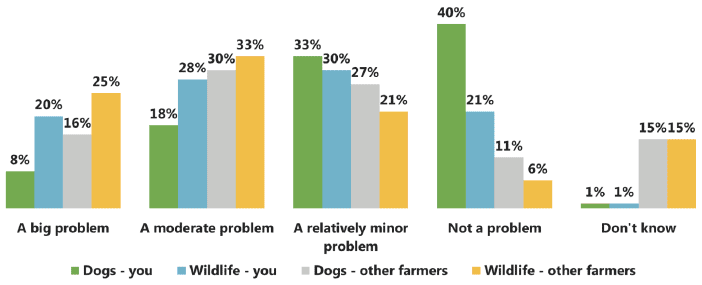
Base: All (n=1931)
Perceptions about whether attacks are increasing
There were mixed views on whether dog attacks were increasing: 38% of respondents thought they were increasing in their area while 41% thought there was no change. Very few (5%) thought they were decreasing. (Figure 4.6).
Those who had experienced more attacks and more recent attacks, and those with a track or road regularly used by dog walkers, were more likely to think they were increasing. Perceptions of an increase were also higher in Lothian (69%), Fife (65%), Argyll & Bute (54%) Tayside (52%) and Clyde Valley (50%). Those in accessible rural (46%) and rural areas (40%) were more likely to think they were increasing than those in very remote rural areas (31%).
A somewhat higher proportion of sheep farmers thought wildlife attacks were increasing: 47% thought they were increasing in their area compared with 35% who thought there was no change. As with dog attacks, very few (3%) thought they were decreasing. (Figure 4.6)
Those who had experienced more wildlife attacks and more recent attacks were more likely think they were increasing and perceptions of an increase were higher in Argyll & Bute (69%) and Eileanan an Iar (56%).
Figure 4.6 Perceptions of whether dog attacks and wildlife attacks are increasing or decreasing in respondent's area (% respondents)
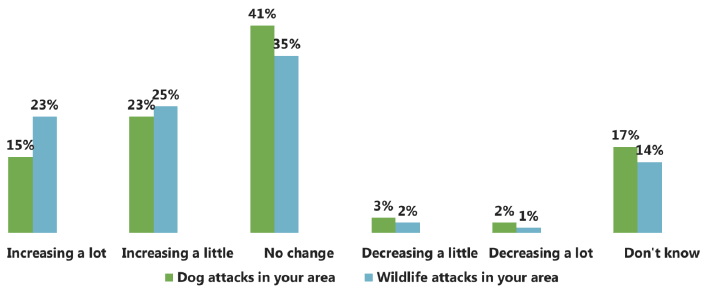
Base: All (n=1931)
Those who thought wildlife attacks were increasing were asked which species they thought were involved. Crows, ravens and foxes were the species most commonly cited (Figure 4.7). (See Section 5 for discussion of actual numbers of attacks by different species). There was considerable variation by area, reflecting the different distribution of species (see Appendix B for more detail).
Figure 4.7 Wildlife species believed to be responsible for increasing numbers of attacks (% respondents)
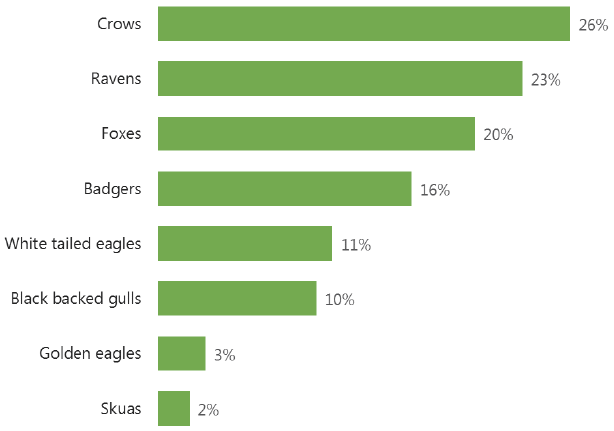
Base: All respondents (n=1931)
Contact
Email: socialresearch@gov.scot
There is a problem
Thanks for your feedback